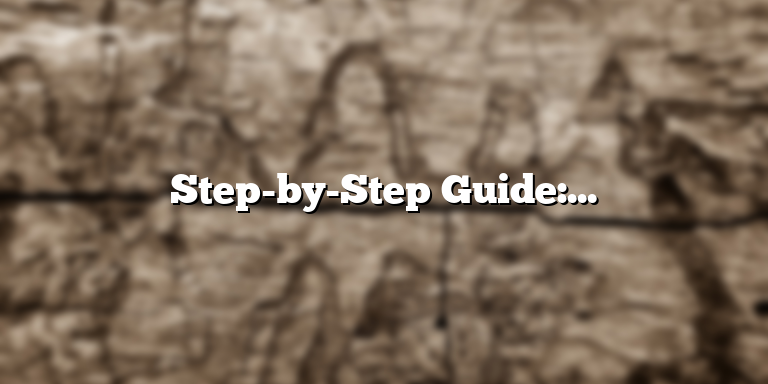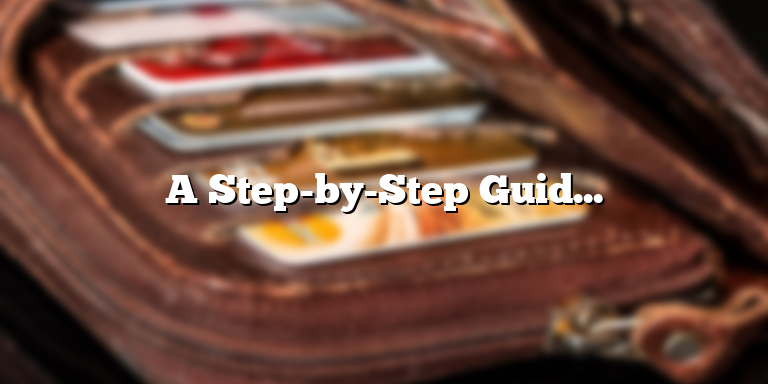
Materials Needed
Before embarking on the process of leather stamping, it is important to gather all the required materials to make the task easy and efficient. The essential tools required for leather stamping include a leather piece, stamping tools, and a mallet.
The leather piece should be free of any blemishes or cuts to achieve a clean and even stamp. It’s important to choose the appropriate leather type for your project, as different types of leather have varying levels of softness and may require different stamping techniques.
For stamping tools, you can either buy a pre-made set or opt to create a kit with individual tools. The type and size of the stamping tools you need will depend on the design and style you’re aiming to create. Common stamping tools include swivel knives, bevelers, edgers, and background texturing tools.
A mallet is required to ensure a firm and even impression of the stamp. It is recommended to choose a wooden or rawhide mallet, as metal or rubber mallets can damage the stamping tools, resulting in an uneven impression.
Preparing the Leather
When it comes to leather stamping, the most crucial step is preparing the leather for the process. This step significantly affects the final result, so it should never be skipped or overlooked. Here are some tips on how to prepare the leather for stamping:
Clean the Leather
The first step in preparing the leather for stamping is to clean it properly. Any dirt or debris present on the leather may hamper the process and cause the stamping to be uneven. Clean the leather using a soft cloth dampened with warm water. Avoid using any harsh chemicals or cleaners as they can damage the leather. If the leather has any stains, use a mild soap solution made with a gentle soap and water. Wipe off any remaining soap residue with a clean damp cloth and let the leather dry completely before proceeding to the next step.
Softening the Leather
Softening the leather is just as important as cleaning it. The leather should be pliable enough to take on the stamp design without any resistance or stiffness. There are many leather conditioners available in the market that can help you soften the leather. Apply a thin layer of conditioner onto the leather and rub it in gently using a soft cloth. Allow the leather to absorb the conditioner for 10-15 minutes before wiping off any excess product. Softened leather will be more receptive to the stamp design, and it will also be easier to work with.
Choosing the Right Stamping Surface
Choosing the right stamping surface is also crucial while preparing the leather for stamping. The stamping surface should be a hard and flat surface that provides even pressure while stamping. Stone, marble, or glass surfaces work well for this purpose. Avoid stamping on uneven or cushioned surfaces such as couches or mattresses, as these surfaces may lead to uneven stamping results. It is always better to test the stamp design on a scrap piece of leather before starting the actual stamping process on the final product.
By following these simple steps, you can prepare your leather for stamping the right way. Proper preparation leads to a smooth stamping process that delivers great results.
Choosing the Right Stamp
If you are planning to stamp leather, the first and foremost thing you need to do is to select the right stamp that complements your design. The stamp that you choose should align with the level of detail, shape, size, and thickness you require for your project.
Stamps come in various shapes and sizes, from geometrical to asymmetrical designs. Some are simple and easy to use while others are intricate and require more skill. You need to decide what design will work best for your leather project before choosing a stamp.
The size of a stamp is also important. Large stamps will require more force and precision during use, while smaller stamps are better suited for intricate details. For instance, if you are working on a large leather piece, a big stamp will be more suitable, while a small stamp is ideal for working on a smaller piece of leather.
The level of detail on the stamp must also be considered. Some stamps have very fine details which are perfect for smaller projects, while others have larger details that are more suitable for larger projects.
It is essential to purchase a high-quality stamp that is durable and can withstand the wear and tear of regular use. A good stamp should be resistant to rust and should be made of strong materials such as steel or brass.
The cost of a stamp is also an important factor to consider. While some are inexpensive, they may not be of good quality and may not last very long. On the other hand, expensive stamps are not always necessary for projects that are simpler in design.
In conclusion, selecting the right stamp is crucial when stamping leather. Pay close attention to the level of detail, shape, size, and the stamp’s material when making a selection. Remember, the right stamp will make your leather project come to life!
Stamping the Leather
One of the most awesome things you can do with leather is to stamp designs on it. If you’re new to leather crafting, don’t sweat it! Stamping the leather is easier than you might think, especially if you stick to some simple guidelines.
First, you need to choose the right stamps. There are endless options available, from letter and number stamps to intricate designs, so you’ll need to choose ones that correspond with the look you’re going for. You can buy individual stamps or sets, and you’ll need something to hold the stamp, such as a stamping tool or simple pliers.
Next, prepare the leather. You don’t want it too thick or too thin. The ideal thickness of the leather should be 3-4 ounces. Anything thicker than that can be difficult to stamp or carve while anything thinner might tear when struck. The leather should also be dampened to soften it a bit and make it more flexible, but not wet to the point that it’s soaking. A small spray bottle is ideal for dampening the leather surface.
Now that you have your leather and stamps ready, it’s time to start. Place the leather on a hard surface and align the stamp where you want it to be placed. Make sure it’s straight and centered, and that it’s not too close to the edge, which could cause the design to “runover” outside of the leather surface. Then, hold the stamp straight and hit it with a mallet with firm and uniform pressure.
Repeat the process for as many stamps as you need to, ensuring that there is enough space between each design. You may want to practice on a scrap of leather first to get a feel for how much pressure you need to apply to make the design clear and consistent. The deeper you press, the more distinct the impression will be on the leather surface.
Once you’re finished stamping the leather, you can let it dry in a cool, dry place. Do not expose it to heat or direct sunlight as it can lead to cracking or discoloration. After it has dried, you can dye, oil, or finish it to further enhance your work of art.
Now you have it. Stamping leather is an excellent way to customize your pieces and add flair. By following these simple steps, you can start impressing your friends and family with your leather crafting skills.
Finishing Touches
Once you have completed your leather stamping project, it is important to ensure that the design you have created is protected and that the leather has a polished appearance. This can be achieved by applying a leather finisher product to the leather surface.
A leather finisher is a type of coating that forms a protective layer over the surface of the leather. It is typically applied to leather goods to provide a protective layer against moisture and staining. There are different types of finishers available in the market, including sprays, liquids, and pastes. Choose the right one that suits your project.
Before applying the finisher, make sure that the leather has been thoroughly cleaned and dried. Applying a finisher on a dirty surface will not only result in an uneven appearance but can also trap dirt within the coating, potentially causing permanent damage to the leather.
If the leather has been dyed, be sure to test a small, inconspicuous area to check for any adverse reactions before applying the finisher over the entire area.
When applying the finisher, use a brush or a cloth and gently spread it evenly over the leather surface. Ensure that you apply a thin layer, making sure that you have covered the entire surface evenly.
Leave the leather to dry completely before handling or storing. Depending on the type of finisher used, the drying time may vary from a few hours to a full day.
Once the leather finisher has dried, it will leave the leather with a glossy or matte appearance depending on the product used. It will also ensure that the stamped design is protected and will last for a long time.
In conclusion, applying a leather finisher is an essential step in the leather stamping process. It adds a level of protection to the surface of the leather and provides a polished appearance. Choose the right finisher for your project, ensure that the leather is clean and dry, and apply the finisher evenly to achieve the best results.






